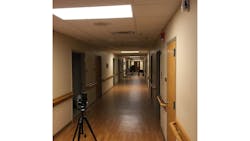Tunable lighting for health: Remember, it also saves energy
The U.S. Department of Energy has a strong inkling that the tunable LED illumination it helped install at two Wisconsin nursing homes is improving the sleep and health of the senior residents. But it knows this much for sure: The lights have slashed energy use compared to fluorescent technology.
DOE’s Pacific Northwest National Laboratory compared the electricity consumption at the two locations to two other care homes in the same state which continued to use conventional lighting.
“Overall, the LED retrofits resulted in more than a 60% reduction in lighting energy use, and greater energy savings were realized through a dimming schedule intended to support restful sleep,” PNNL stated in its report, Lighting in Senior Care Centers: Comparing Tunable LED Systems to Conventional Lighting Systems in Four Senior Care Centers.
The savings were as high as 79% in corridors and dining rooms according to PNNL, which worked on the project along with lighting design and installation firm Energy Performance Lighting (EPL) and Midwest Lighting Institute, a research group funded by EPL and others. EPL and Midwest share a location in Cottage Grove, Wisc. PNNL is based in Richland, Wash., and run by Columbus, Ohio-based nonprofit science and technology development outfit Battelle.
The 75-bed Maple Ridge Care Center in Spooner and the 74-bed Oak Ridge Care Center in Union Grove received the new LED luminaires, while the 50-bed Montello Care Center in Montello and the 38-bed Hope Health and Rehabilitation Center in Lomira served as the fluorescent comparison sites.
While “LED energy savings” might be an old story by now, it is one that is taking on new relevance as geopolitical events push global energy prices through the roof.
Meanwhile, the three parties are monitoring the health benefits of the tunable LEDs, generally designed to deliver bright light during the day with a cooler color temperature, and dimmer, warmer light during evening hours. Those lighting parameters are believed to facilitate healthier sleep/wake cycles, which can assist the wellbeing of residents who tend not to benefit from getting outdoors on a regular basis.
Tunable, circadian lighting mimics the patterns of the sun’s day/night cycle. While natural light is regarded as a far superior means of fostering circadian health, tunable artificial light can help.
The team in Wisconsin wants to examine, among other things, lighting’s effect on dementia residents at the two locations. It has yet to publish those findings.
“Future studies are needed to evaluate tunable lighting strategies in relation to medical outcomes, and to provide evidence-based lighting recommendations for residents with dementia or other medical conditions,” PNNL states in the report.
“Additionally, work with portable technologies, such as sleep mats or other light monitoring devices, could be used to evaluate individual sensitivities and subsequently provide resident level feedback to doctors and nursing staff,” the lab team notes. “Appropriate timing and duration of effective light throughout the day is just beginning to become established. Individual sensitivities, lifestyles, and behaviors may play a role in determining the ‘ideal’ light exposure.”
Lighting-related dementia research is gaining attention. A Danish care home, for example, is examining personalized approaches, working with a European consortium known as PerCiLight, led by Aarhus, Denmark–based Chromaviso.
Access the full PNNL report from the DOE website.
Further investigations into light and health
Human-centric lighting, aka circadian lighting, has been emerging as an application for years
Studies on light’s impact on the wellbeing of dementia patients is only one angle
Established light & health researchers continue to seek ways to define ‘healthy’ light exposure and apply it to the human condition
MARK HALPER is a contributing editor for LEDs Magazine, and an energy, technology, and business journalist ([email protected]).
For up-to-the-minute LED and SSL updates, follow us on Twitter. You’ll find curated content and commentary, as well as information on industry events, webcasts, and surveys on our LinkedIn page and our Facebook page.

Mark Halper | Contributing Editor, LEDs Magazine, and Business/Energy/Technology Journalist
Mark Halper is a freelance business, technology, and science journalist who covers everything from media moguls to subatomic particles. Halper has written from locations around the world for TIME Magazine, Fortune, Forbes, the New York Times, the Financial Times, the Guardian, CBS, Wired, and many others. A US citizen living in Britain, he cut his journalism teeth cutting and pasting copy for an English-language daily newspaper in Mexico City. Halper has a BA in history from Cornell University.





![The DesignLights Consortium continues to make progress in shifting outdoor lighting products and implementation practices toward a more restrained and thoughtful strategy. [Image does not represent a DLC qualified fixture.] The DesignLights Consortium continues to make progress in shifting outdoor lighting products and implementation practices toward a more restrained and thoughtful strategy. [Image does not represent a DLC qualified fixture.]](https://img.ledsmagazine.com/files/base/ebm/leds/image/2024/08/66be810888ae93f656446f61-dreamstime_m_265700653.png?auto=format,compress&fit=&q=45&h=139&height=139&w=250&width=250)
